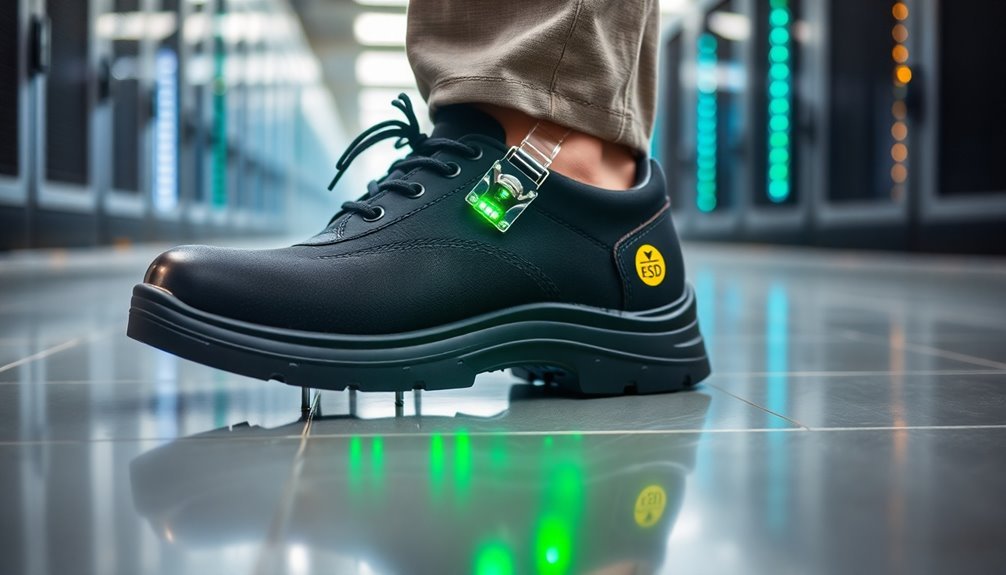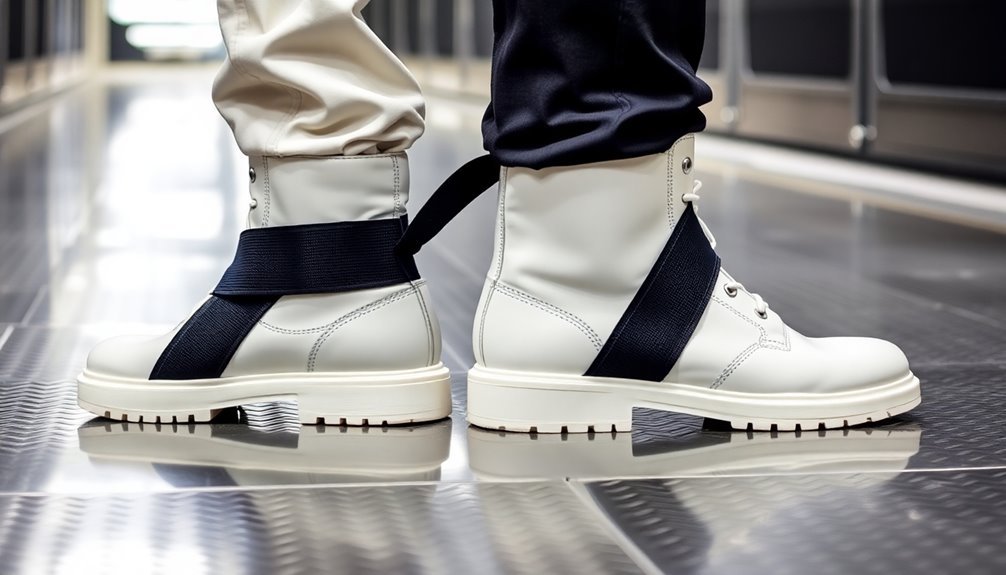When working in a datacenter, you'll need proper ESD (Electrostatic Discharge) footwear to protect sensitive electronic equipment. Choose shoes marked with SD-100, SD-35, or SD-10 on the ASTM label and verify they have an electrical resistance between 10^6 and 10^8 ohms. Test your shoes daily with a resistance meter before starting work, and keep them clean and dry to maintain their static-dissipative properties. Don't wear them outside the facility, and always pair them with ESD floor mats for complete protection. Understanding proper ESD footwear practices is just the first step in maintaining a safe datacenter environment.
Understanding ESD Footwear Basics

A single spark of static electricity can wreak havoc in sensitive electronic environments. That's why you'll need proper ESD (Electrostatic Discharge) footwear when working with sensitive electronic equipment in datacenters. These specialized shoes are designed to protect both you and valuable equipment by safely channeling static electricity to the ground.
Your ESD shoes work by creating a conductive pathway through their specially engineered soles, which contain carbon or metallic particles mixed into PU or PVC materials. When you wear them, they continuously dissipate static charges that build up on your body, preventing potentially damaging discharges. The shoes' low electrical resistance allows for quick and efficient charge dispersion.
To be effective, your ESD footwear must meet strict safety standards, including EN IEC 61340-4-3 or EN IEC 61340-5-1. The shoes' electrical resistance must fall between 0.1 MOhm and 100 MOhm, ensuring proper static dissipation.
Don't confuse these with standard antistatic shoes, which have different resistance values and aren't specifically designed for electronic protection. For maximum protection, you'll want to use your ESD shoes in combination with ESD floor mats, creating a thorough static control system in your workspace.
Selecting the Right ESD Shoes
When selecting ESD shoes, you'll need to consider both comfort features like proper toe space and heel support, along with essential protection ratings below 35 megaohms.
Regular twice daily testing of your ESD footwear ensures consistent static dissipative performance throughout your shift. You should guarantee the shoes meet material standards for durability, including resistance to fuel oils and impact protection of up to 200 Joules.
It's vital to choose shoes that offer the right combination of breathable materials and conductive properties while maintaining a secure fit throughout your workday.
Comfort and Fit Features
Selecting the right ESD shoes boils down to finding the perfect balance between safety and comfort. You'll want to focus on breathable materials that keep your feet cool during long shifts in the datacenter.
Look for shoes with ergonomic designs and cushioned insoles, as these features help prevent foot fatigue and potential discomfort during extended periods of wear. Consider footwear with a dual Velcro design to minimize tripping risks and make putting on and removing shoes easier.
When it comes to fit, you'll need to think about both your foot size and width carefully. Proper fit isn't just about comfort—it's crucial for guaranteeing the effectiveness of the anti-static properties.
Choose from comfort-focused styles like clogs and sneakers, or if you're in management, opt for formal ESD shoes that complement your business attire. Make sure your chosen footwear provides adequate arch support through balanced insoles.
Pay attention to the shoe's construction materials. Soft, durable leather is an excellent choice as it offers both comfort and longevity. You'll also want to verify that the shoes maintain proper contact with the floor for ideal static dissipation.
ESD Protection Ratings
Beyond comfort considerations, understanding ESD protection ratings forms the backbone of proper safety footwear selection.
When you're selecting ESD footwear for datacenter work, you'll need to verify that the shoes maintain electrical resistance between 10^6 and 10^8 ohms, which provides the ideal balance for static dissipation. For optimal performance, avoid foot powders as they can interfere with the static dissipative properties.
Look for shoes with clear SD-100, SD-35, or SD-10 markings on their ASTM label. These ratings indicate the footwear meets essential standards like ASTM F2413 and ISO 20345.
You'll want to distinguish between ESD and other electrical ratings – ESD shoes differ from EH (Electrical Hazard) footwear, which is nonconductive, and CD (Conductive) footwear, which allows unrestricted static flow.
When selecting your ESD shoes, you'll need to evaluate your specific workplace conditions. The effectiveness of ESD protection can be affected by the insoles and socks you wear, so guarantee your entire footwear system maintains proper static control.
Don't forget to check for certification labels, typically shown as a green "SD" on a yellow rectangle, confirming the shoes meet required safety standards for datacenter environments.
Materials and Durability Standards
Through careful material selection and rigorous durability standards, ESD footwear delivers essential protection for sensitive electronic environments.
When selecting your ESD shoes, look for high-quality split leather construction that combines durability with comfort during long shifts. The conductive outsoles should efficiently channel static charges to the ground, while breathable materials help maintain comfort throughout your workday. Proper footwear certification must include certification agency logos permanently marked on the outside of the shoes.
You'll need to verify that your footwear meets specific electrical resistance requirements. Static dissipative shoes must maintain resistance between 10^6 and 10^8 ohms, while conductive footwear should range from 0 to 500,000 ohms.
Your shoes must also pass stringent durability tests, including puncture resistance of 270 lbs and flexibility testing of 1.5 million flexes without cracking.
Make sure your ESD footwear complies with key standards like ASTM F2413 and EN ISO 20344:2004. Testing should verify performance in both wet and dry conditions, with proper electrical resistance maintained throughout.
When working in data centers, your shoes' static control properties must work effectively with ESD flooring to create a complete protection system.
Daily Safety Inspection Protocol

You'll need to start each workday by testing your ESD footwear with a resistance meter to verify proper static dissipation.
During the pre-shift inspection, check for any dirt, debris, or chemical residue that could interfere with the conductive properties of your shoes.
ANSI/ESD standards require maintaining resistance below 10E9 ohms for proper static protection in electronics environments.
Remember to document your test results and immediately address any readings that fall outside the acceptable resistance range specified in your facility's safety guidelines.
Pre-Shift Testing Checklist
Safety consciousness begins with a thorough daily inspection of anti-static footwear before each shift. You'll need to examine your footwear carefully, checking for visible damage, wear patterns, and confirming all components are securely attached.
Pay special attention to the soles, looking for cracks or excessive wear that might compromise their anti-static properties. A complete 100% visual inspection should be performed to meet industry quality standards.
You must perform several functional tests before starting your shift. Flex the heel to verify durability, and check for any exposed nails or sharp components that could cause injury. Test the sole's bond strength and pull on all attachments like zippers and buckles to confirm they're secure. Don't forget to verify the footwear's electrical conductivity properties.
Your footwear must comply with ASTM International standard F2413 and OSHA regulations for protective equipment. Document your inspection results for compliance and auditing purposes.
If you're unsure about proper testing procedures, consult your safety training materials or supervisor. Remember, it's your responsibility to maintain and regularly inspect your anti-static footwear to confirm it's providing the protection you need in the datacenter environment.
Resistance Meter Requirements
After completing your visual inspection, your next step is using a properly calibrated resistance meter to verify your footwear's anti-static properties.
You'll need to confirm your meter meets specific requirements for accurate testing in data center environments. Your resistance meter must be regularly calibrated according to manufacturer specifications and designed specifically for static-sensitive areas.
Select a meter that provides clear, easy-to-read measurements and alerts when resistance levels exceed acceptable thresholds. The device should be portable enough for convenient daily testing while meeting all industry standards for static electricity measurement tools.
When using the meter, you'll need to conduct tests in a controlled environment to minimize interference that could affect your readings. Regular testing is particularly important since maintaining 65-70 degrees Fahrenheit is critical for proper equipment operation.
Keep detailed records of your test results for compliance purposes and compare them against industry-standard thresholds. You should watch for any trends in the readings, as consistently high measurements may indicate it's time to replace your footwear.
If you notice readings above acceptable levels, don't enter the data center – replace your footwear immediately. Remember, while low resistance readings are good, you'll still need to take into account other environmental factors for complete static protection.
Contamination Prevention Guidelines
During daily inspections, maintaining strict contamination prevention protocols is essential for data center safety. You'll need to verify that all doors remain securely closed when not in use and check that contamination control mats are properly placed at each entrance.
Make certain designated staging areas outside the facility are being used correctly for unpacking and inspecting items before they enter the controlled environment.
As you conduct your inspection, you'll want to document any signs of prohibited items like food, drinks, paper, or cardboard inside the data center. Check that work areas are properly isolated during maintenance tasks, and confirm that high-efficiency particulate air vacuums are being used near maintenance zones.
Don't forget to use your Computerized Maintenance Management System (CMMS) to track your findings and any necessary corrective actions.
You should also verify that all employees are following proper PPE protocols and anti-static safety measures. If you notice any gaps in contamination control practices, report them immediately and make certain they're addressed through updated training programs or revised safety procedures.
Regular documentation of these inspections helps maintain compliance with Environmental Health and Safety programs.
Proper Storage and Maintenance
Proper care and diligence in storing and maintaining your anti-static footwear substantially prolongs its lifespan and guarantees reliable protection.
Store your shoes in a clean, dry, well-ventilated area, keeping them at least 200mm away from walls and ground, and 1m from heat sources. Don't expose them to direct sunlight, extreme temperatures, or harsh chemicals.
Before storage, clean your shoes using warm water (below 40°C) and a neutral cleaning agent. After cleaning, let them dry naturally in a cool place. For leather shoes, apply polish regularly to prevent mildew and maintain surface integrity.
Essential maintenance checks should include:
- Inspecting for cracks, tears, or excessive wear on outsoles and stitching
- Conducting resistance tests within 200 hours of use
- Checking for any debris stuck to the soles
- Verifying anti-static properties remain effective
When wearing your anti-static footwear, avoid using insulated woolen socks or insoles, as these can compromise the shoe's protective properties. If you notice salt frost, clean it immediately using gauze or cotton with warm water, then dry naturally and reapply polish. Replace worn-out shoes promptly to maintain safety standards.
Common Static Hazards

Static hazards extend far beyond simple shocks and discomfort – they pose serious risks in modern workplaces, particularly in data centers and electronic environments. You'll face several critical hazards when working with sensitive IT equipment that can be damaged by as little as 25 volts of discharge.
| Hazard Type | Impact | Prevention |
|---|---|---|
| Equipment Damage | Burns in components, system crashes | Use anti-static footwear and wrist straps |
| Data Corruption | Lost information, system failures | Maintain proper grounding measures |
| Dust Attraction | Reduced airflow, overheating | Regular cleaning, static control flooring |
Your movement through the facility can generate significant static voltages, especially on high-pressure laminate flooring. Common items like plastic trash cans, computer peripherals, and packaging materials also contribute to static buildup. Without proper precautions, you risk triggering equipment failures or data loss.
The combination of low humidity and movement can create dangerous static levels. You'll need to be particularly cautious when handling equipment or moving through areas with sensitive electronics. Remember that static damage isn't always immediately visible – it can cause gradual deterioration or intermittent failures that are difficult to diagnose.
ESD Standards for Data Centers
You'll need to understand the testing requirements for your data center's ESD footwear, which must maintain resistance readings between 10^6 and 10^9 ohms when tested with a megohmmeter.
Your anti-static shoes require regular verification using a footwear tester before entering sensitive areas, ensuring they meet ANSI/ESD S20.20 certification standards.
Different certification levels exist for various data center environments, from basic static dissipative footwear for general use to highly specialized conductive footwear for Class A1 facilities operating at wider temperature and humidity ranges.
Testing Requirements and Protocols
Testing requirements for ESD flooring in data centers follow several essential industry standards, including ANSI/ESD S20.20-2021 and IEC 61340-5-1. You'll need to verify that your facility's flooring meets the maximum resistance measurement of 1.0 x 10^9 ohms to ground, while also considering minimum values for ideal performance.
When testing ESD flooring materials, you must evaluate these critical factors:
- Charge generation performance at the lowest operational humidity levels
- Electrical resistance measurements with and without ESD footwear
- Decay time measurements for material qualification
- Compliance with both industry standards and electrical codes
You'll find that conductive vinyl and rubber floors offer the best performance in data center environments. Conductive rubber floors are particularly effective, showing only a 0.1% probability of generating charges above 500V, while vinyl floors maintain a relatively low 8% probability.
These materials work effectively even without specialized ESD footwear, which is vital for maintaining consistent protection.
Remember that proper testing protocols don't just guarantee compliance; they enable you to operate your data center within wider temperature and humidity ranges while reducing energy costs associated with humidification control.
Certification Levels Explained
Data center certification levels break down into distinct tiers that reflect your facility's commitment to ESD protection and safety standards.
UL 3223 certification serves as a primary benchmark, requiring your data center to maintain a PUE of 1.5 or lower while meeting strict safety protocols for ESD control. You'll need to comply with thorough guidelines outlined in ANSI/ESD S20.20-2021 and IEC 61340-5-1 for protecting electronic equipment.
For enhanced environmental credentials, you'll find LEED certification offers four progressive tiers: Certified, Silver, Gold, and Platinum. Each level demands stricter adherence to sustainability practices, including proper ESD controls that don't rely solely on humidity management.
You'll save significant energy by implementing ASHRAE TC 9.9's recommended approach of using ESD flooring and footwear instead of traditional humidity controls.
When you're pursuing certifications, you'll need to demonstrate compliance with specific ESD standards like ANSI/ESD S6.1-2019 for grounding requirements and ANSI/ESD S541-2019 for packaging protocols. These certifications guarantee you're protecting against critical voltage levels that can exceed 6 kV during routine activities, while maintaining operational efficiency and safety.
When to Replace ESD Shoes

Professionals working in ESD-sensitive environments need clear guidelines for replacing their protective footwear.
Your ESD shoes require replacement after 200 hours of use or when they fail static resistance testing. Don't wait for visible damage – regular testing is essential to maintain proper protection levels.
You'll need to replace your ESD footwear in these specific situations:
- After 200 hours of active wear, regardless of visible condition
- When you notice cracks, tears, or substantial wear on soles
- If the shoes fail resistance testing during routine checks
- When the manufacturer's timeline (typically 3 months) has elapsed
Keep in mind that your work environment greatly impacts replacement frequency. If you're working in areas with high static electricity levels or harsh conditions, you might need to replace your shoes more frequently than the standard timeline suggests.
Track your shoes' performance through weekly cleaning and regular resistance testing. You should document all inspections and tests to maintain compliance and identify patterns in wear.
Don't forget that proper storage in a dry environment and regular maintenance can extend your ESD footwear's lifespan while ensuring consistent protection.
Essential ESD Footwear Features
Four critical features define effective ESD footwear: proper electrical resistance, conductive materials, safety-focused design, and wearer comfort.
When it comes to electrical resistance, you'll need footwear that maintains person-to-ground resistance below 3.5 x 10^7 ohms. Your ESD shoes should fall within the resistance range of 1 x 10^6 to 1 x 10^8 ohms, guaranteeing effective static dissipation while keeping the total system resistance under 1.0 x 10^9 Ω.
The shoes must incorporate conductive materials throughout their construction. Look for outsoles made from conductive rubber or polyurethane, and uppers containing carbon or metallic particles. You'll also find silver thread stitching that enhances conductivity.
Design elements should include a clear conductive path from your foot to the ground, closed heels for protection, and non-slip properties. Many models feature steel toes and steel plate midsoles for additional safety.
For comfort, you'll want breathable materials like leather, mesh, or microfiber lining. Make sure the shoes provide proper arch support and balanced insoles. Check for the ESD marking to confirm compliance, and guarantee there's adequate toe room for extended wear.
Best Practices for Wearing

Wearing ESD footwear properly boils down to a few essential practices. You'll need to maintain continuous contact with ESD flooring while working in the datacenter, ensuring your shoes or conductive sole straps provide full electrical connection even when your feet are partially lifted.
Don't wear your ESD footwear outside the facility, as this can contaminate the conductive materials and reduce their effectiveness.
For ideal static protection, you should match your footwear with compatible flooring materials. Here's what works best:
- Conductive rubber floors work with all ESD footwear types
- ESD epoxy floors require sole straps or ESD shoes
- Static-dissipative carpet needs grounded footwear
- Regular carpet isn't suitable for ESD protection
You'll need to inspect your ESD footwear regularly for signs of wear and tear. Clean them consistently to maintain their static-dissipative properties, and replace them immediately if you notice any damage.
Remember that your footwear must meet ANSI/ESD S20.20 guidelines, which specify that footwear-flooring combinations shouldn't generate more than 100 volts of static in electronics handling environments.
Complementary Static Control Equipment
Along with proper ESD footwear, a complete static control system requires several complementary pieces of equipment to guarantee thorough protection.
You'll need to confirm your workspace has conductive flooring, which can include ESD tiles, anti-static floor paint, or ESD mats. These materials substantially reduce the probability of generating high static charges, with conductive rubber floors having only a 0.1% chance of allowing charges over 500 volts.
Your workstation must be equipped with an ESD table mat to provide a grounded surface for handling sensitive electronic components. Remove all non-essential plastic items like regular trash cans and pens, replacing them with ESD-safe versions.
You'll also need to use a wrist strap connected to a common ground point for direct personnel grounding.
If you're not using permanent ESD footwear, you can opt for heel straps or sole straps as temporary solutions. Heel straps work with regular shoes and are ideal for visitors, while sole straps provide full coverage for better conductivity.
Remember to regularly inspect all your static control equipment and participate in training sessions to maintain proper safety standards.
Testing Your ESD Footwear

To maintain the highest level of ESD protection, you'll need to test your ESD footwear daily before entering sensitive areas. The testing process verifies your shoes maintain resistance levels between 750 Kiloohms and 35 megohms, keeping you and sensitive equipment safe from static discharge.
When testing your ESD footwear, you'll need to use a properly grounded tester with a dual foot plate. Stand on the plate, press the test button, and check if your readings fall within the acceptable range. Make sure you've got good skin contact with your footwear during testing.
Here are the essential components you'll need for thorough ESD footwear testing:
- A grounded testing station with dual foot plates
- Surface resistance tester
- Two 5-pound electrodes for pressure testing
- Handheld electrode for verification
Your facility's EPA compliance depends on proper testing procedures. If you're using heel straps, place them on an insulative surface and test with appropriate electrodes.
Remember that testing isn't just about the footwear – it's part of a system test that includes your facility's flooring materials. Following IEC and ESD standards verifies you're maintaining the right resistance range of 1 x 10^6 to 1 x 10^8 ohms.
Training and Documentation Requirements
While testing procedures verify your ESD footwear functions properly, thorough training and documentation form the backbone of an effective static control program.
You'll need to participate in extensive training sessions that cover proper footwear selection, usage guidelines, and maintenance procedures to guarantee superior static protection in your data center environment.
You must understand ANSI/ESD S20.20 requirements, which specify that your footwear-flooring system shouldn't generate more than 100 volts of static. Keep detailed records of your training attendance and maintain documentation of your footwear's compliance with these standards.
You'll also need to participate in regular refresher courses to stay current with safety protocols and new technologies.
Your employer will maintain written policies about ESD footwear use in designated areas, and you're required to follow these guidelines consistently. You'll need to verify that your anti-static footwear is clearly marked and identifiable for compliance purposes.
Regular audits will verify that you're using your ESD footwear correctly and maintaining it in good condition. Remember to document any issues or concerns about your footwear's performance to help maintain workplace safety standards.
Frequently Asked Questions
Can I Wear ESD Shoes While Driving My Car Safely?
You shouldn't wear ESD shoes while driving. They're designed to discharge static electricity, which could interfere with your car's electronic systems. It's safer to change into regular shoes for driving.
Do ESD Shoes Protect Against Electric Shock From Power Outlets?
No, your ESD shoes won't protect you from electric shock from power outlets. They're designed to dissipate static electricity to protect electronic equipment, not to shield you from high-voltage electrical sources.
Will Wearing ESD Shoes Affect My Height Measurement During Medical Examinations?
No, your ESD shoes won't affect your height measurement during medical exams because you'll typically be asked to remove all footwear. Medical professionals take height measurements barefoot to guarantee accurate results.
Can I Wear Regular Socks With ESD Shoes, or Only Special Ones?
You should wear special ESD socks with ESD shoes for reliable protection. While you can wear regular socks, they won't provide consistent grounding and may cause your footwear to fail resistance tests.
Are ESD Shoes Waterproof When Working in Data Centers With Cooling Systems?
While your ESD shoes aren't completely waterproof, they'll typically offer some water resistance. You won't need full waterproofing in data centers, as cooling systems create controlled humidity rather than wet conditions you'd walk through.
In Summary
You're now equipped to protect sensitive equipment and maintain a safe datacenter environment through proper ESD footwear practices. Remember to test your shoes daily, keep up with maintenance, and follow your facility's documentation requirements. Don't forget that ESD footwear is just one part of a complete static control program – combine it with other protective measures for maximum effectiveness in your datacenter operations.





Leave a Reply